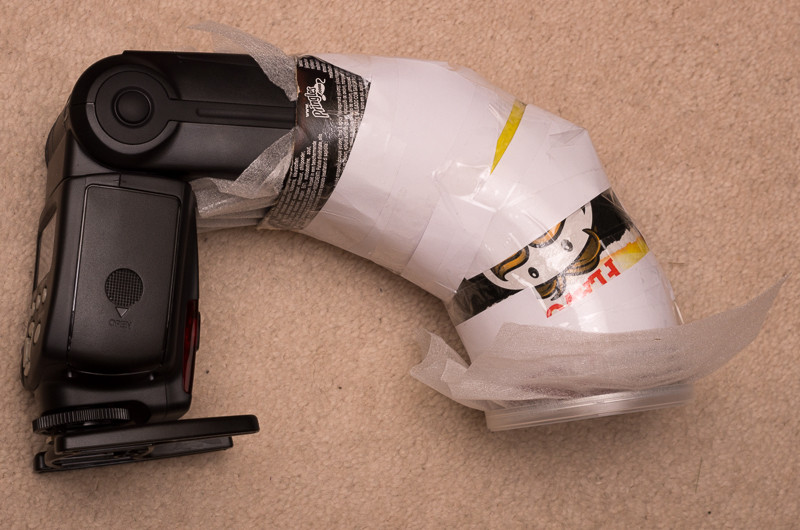- Messages
- 4,182
- Name
- Paul
- Edit My Images
- Yes
This is probably a silly question, but...
I've just finish cannibalising a pringles tube (thanks @Carlh et al) and have now made a second home-made flash adaptor to go with my much bigger and multi-purpose lampshade / baby-muslin diffuser. This new one comprises rings of pringle tube sections (for strength) held together with heavyweight (high gsm) white paper and sellotape. I will be getting more tape (both white to reflect and black insulation tape for the outside) in due course. It's not elegant, but it seems to do a good job of redirecting my on camera flash down to just the right place in front of my 50mm lens with Raynox attached. Best of all, I no longer need one hand to hold my flash off camera:

Now, my flash (well, one of them - not the one in shot above) is HSS compatible and it got me thinking: if light quantity isn't an issue, is there any downside to using a high shutter speed (e.g. 1/500) and HSS for macro shots? I'd assume in most cases the real issue IS quantity of light, so HSS is a stupid idea as it just reduces the flash power and you're letting less ambient in with the high shutter speed. BUT... if I'm shooting outside where light quantity isn't a problem, does HSS - or more specifically, using a high shutter speed - make some sense for macro shots? The problem I'm wondering whether it helps solve is camera shake - especially if we're shooting in windy conditions.
Anybody have any views or experience with this?
I've just finish cannibalising a pringles tube (thanks @Carlh et al) and have now made a second home-made flash adaptor to go with my much bigger and multi-purpose lampshade / baby-muslin diffuser. This new one comprises rings of pringle tube sections (for strength) held together with heavyweight (high gsm) white paper and sellotape. I will be getting more tape (both white to reflect and black insulation tape for the outside) in due course. It's not elegant, but it seems to do a good job of redirecting my on camera flash down to just the right place in front of my 50mm lens with Raynox attached. Best of all, I no longer need one hand to hold my flash off camera:

Now, my flash (well, one of them - not the one in shot above) is HSS compatible and it got me thinking: if light quantity isn't an issue, is there any downside to using a high shutter speed (e.g. 1/500) and HSS for macro shots? I'd assume in most cases the real issue IS quantity of light, so HSS is a stupid idea as it just reduces the flash power and you're letting less ambient in with the high shutter speed. BUT... if I'm shooting outside where light quantity isn't a problem, does HSS - or more specifically, using a high shutter speed - make some sense for macro shots? The problem I'm wondering whether it helps solve is camera shake - especially if we're shooting in windy conditions.
Anybody have any views or experience with this?

